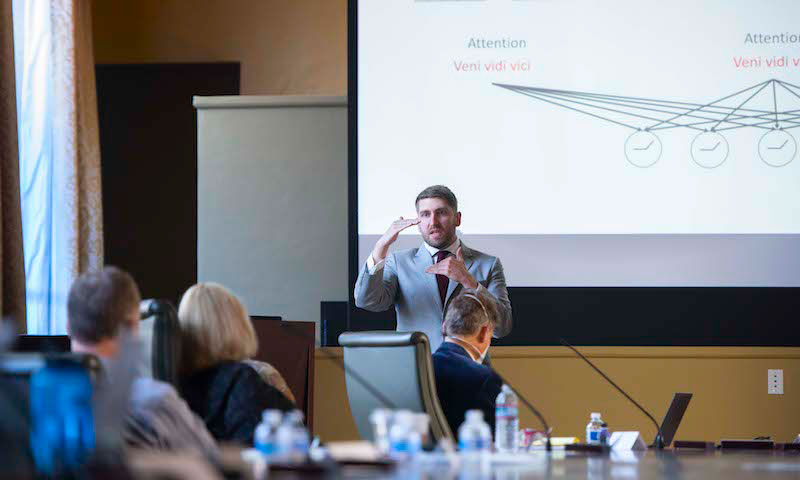The Naval Postgraduate School (NPS), in partnership with Stanford University and the Defense Innovation Unit in Silicon Valley, developed an intensive three-day course specifically for senior defense leaders on the emerging role of Artificial Intelligence and Machine Learning (AI/ML) in the military.
Developed under the direction of the DOD’s Chief Digital and Artificial Intelligence Office (CDAO), the inaugural executive AI course, held June 7-9, provided approximately two dozen General and Flag Officers, Senior Executive Service (SES) and other senior executives with a foundational knowledge of AI/ML systems, including technical cornerstones, practical implications, ethical guidelines and DOD-specific problems and solutions. With the success and positive feedback of the initial event, additional courses are planned for November 2022 and February 2023.
“This is not about a new thing, a new shiny object,” noted NPS President retired Vice Adm. Ann E. Rondeau in kicking off the inaugural course. “This is a fundamental belief in the existential condition of the nation.
“Data and digital literacy, especially combined with quantum technology literacy, is a daunting task,” she continued. “It’s not meant for all of us to master this, but it’s important to be able to ask those hard questions and bring our teams together so that they can do this collaboratively, because this is truly a collaborative, interdisciplinary challenge.”
Artificial intelligence can be defined as machines making rational decisions and actions, or augmenting human intelligence for making better-informed decisions. A subset of AI, machine learning represents machines’ ability to learn, often from large amounts of data, to make fast, accurate predictions. The technologies have already brought extensive changes to the nation, from Internet search engines to self-driving automobiles, speech and handwriting recognition to medical diagnoses, and precision agriculture to computational economics. And more!
AI/ML systems have had a profound impact on the Armed Forces as well. Virtually every aspect of the military has been affected, not only in the emergence of new forms of warfare (e.g., unmanned and autonomous weapons systems, cyber warfare, and intelligence, surveillance and reconnaissance [ISR] platforms) but also in logistics, maintenance, procurement, global communications, operations research, manpower affairs, program management as well as new ethical considerations.
“Technologies like artificial intelligence and machine learning are going to play a key role in our national defense, and in our ability to keep pace with our adversaries,” noted course attendee U.S. Air Force Maj. Gen. Mark Slocum, Director of Global Operations, U.S. Air Force Air Combat Command. “Understanding these technologies is paramount, but not just from a technical perspective.
“This course was uniquely valuable in that it focused on providing critical information on AI and ML from the perspective of leadership, and how best we can shape our organizations and support our capable teams in leading the fight through the inception, implementation, and fielding of systems that embed this critical emerging technology,” Slocum continued. “The course content and speakers drew from a wealth of DOD examples, experiences and insights, which made it immediately relevant to my command’s mission and challenges.”
The CDAO was formally stood up in February 2022 to accelerate the DOD’s adoption of data, analytics and AI to generate decision advantage “from the boardroom to the battlefield,” notes the organization’s website. The organization is charged with building a strong foundation for data, analytic and AI-enabled capabilities to be developed and fielded at scale. A key part of this responsibility is ensuring the DOD has the “necessary people, platforms and processes needed to continuously provide business leaders and warfighters with agile solutions.”
Accomplishing this goal is what brought CDAO to NPS, Stanford University’s Human-Centered AI Institute and the Defense Innovation Unit in Silicon Valley to develop the initial executive AI course. Subjects covered included neural networks, DOD-specific ethical considerations, program management, operational experimentation and deployment, classified AI/ML projects and research, AI in the future of warfighting, and human-machine teaming, amongst others.
“Our speakers brought their wealth of experience in AI and ML to the table, and before a discerning audience who bear a lot of responsibility for adopting this new technology to keep our nation secure,” noted Associate Professor Mathias Kolsch in the NPS Department of Computer Science, the university’s lead on course development.
“The relevancy of the presented content was exceptional,” he added. “Faculty from NPS and Stanford’s Human Centered AI Institute (HAI), the Gordian Knot Center for National Security Innovation, and the Defense Innovation Unit, as well as three distinguished entrepreneurs of the Silicon Valley tech industry were able to convey it in a concise, highly informative, and engaging fashion.”
For U.S. Air Force Maj. Gen. Stacey Hawkins, Commander of the Air Force Sustainment Center, this was transformational.
“Not only did it strengthen connective tissue between key stakeholders within the USAF Air Combat Command senior directorate leaders [at the general officer level], it provided strategy recommendations for brokerage across the Air Force sustainment enterprise leveraging AI/ML as an enabler to the Air Force warfighting mission,” said Hawkins.
“The NPS lecturers were extraordinary as well as the key collaboration with Stanford University in broadening the academic discussion accounting for geopolitical factors,” he continued. “The symposium accelerated USAF Air Combat Command organization’s journey toward making AI/ML a part of our Combat Air Forces mission culture.”
As the development team shifts focus to future planned executive courses, Kolsch says the partners are well positioned to continue providing this critical support of the CDAO’s mission.
“We are very thankful for HAI to hosting us for one of the three days, to DIU’s essential contributions, and of course to the Workforce Education group, education staff, and organizers at the CDAO – and previous Joint AI Center – who shaped this course together with us and who extended their trust to NPS to hold this event,” he said.


